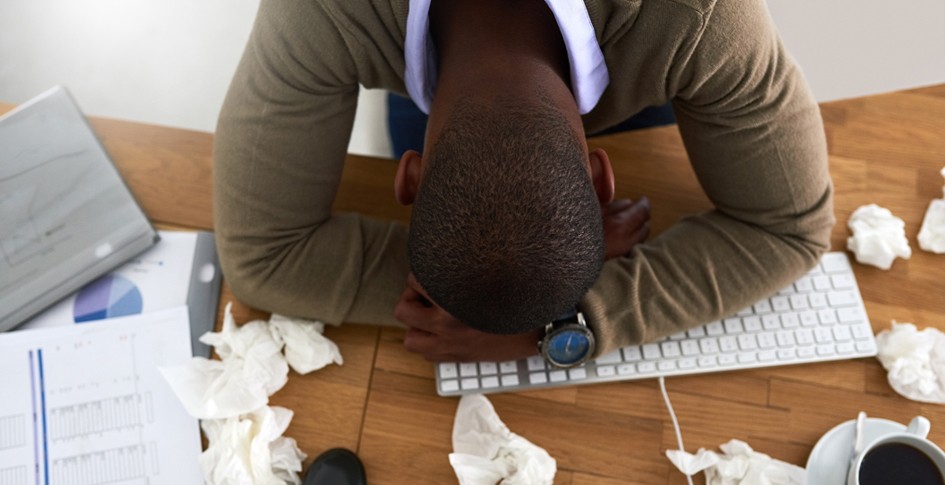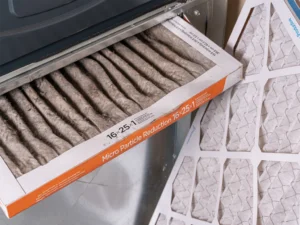Business owners, are your employees complaining of headaches, nausea, or fatigue when they work from the office? Building managers, do your tenants call you to fix the HVAC system when nothing seems broken? If so, your employees and tenants may be suffering from Sick Building Syndrome (SBS).
A Summary of Sick Building Syndrome
The term “Sick Building Syndrome” is sometimes used inconsistently; (often, it is confused with the subject of the next article, Building-Related Illness). We will use the official EPA definition for this article: “The term ‘sick building syndrome’ (SBS) is used to describe situations in which building occupants experience acute health and comfort effects that appear to be linked to time spent in a building, but no specific illness or cause can be identified.” In general, Sick Building Syndrome sufferers tend to feel better shortly after leaving the building.
Signs of Sick Building Syndrome
According to the EPA, the main sign of Sick Building Syndrome is people in the building complaining of non-life-threatening symptoms such as “headache; eye, nose, or throat irritation; dry cough; dry or itchy skin; dizziness and nausea; difficulty in concentrating; fatigue; and sensitivity to odors.”
However, not everyone in the building needs to experience these symptoms for something to be wrong. According to the Canadian Centre for Occupational Health and Safety (CCOHS), “Some people may be more sensitive than others or have pre-existing health conditions. Some people may be exposed to more contaminants in the building than others and they may experience symptoms earlier than other people, or experience more severe symptoms.” For instance, someone with allergies sitting right next to a moldy air conditioning vent is far more likely to experience symptoms than someone without allergies sitting across the room. The key point is that one must take employee and tenant claims of health effects seriously, regardless of whether everyone is experiencing the same symptoms to the same degree.
What Causes Sick Building Syndrome?
Since the causes of Sick Building Syndrome are unknown by definition, your first job as a building manager is to determine the said cause. Once you know what causes Sick Building Syndrome, it’s not Sick Building Syndrome anymore, but rather a specific and solvable problem. A NIOSH survey of 203 indoor spaces with SBS complaints found the following causes in order of frequency:
- Inadequate ventilation: Results in “low levels of multiple contaminants.”
- Indoor contaminants: e.g., fumes from pesticides or office equipment.
- Infiltration of outdoor contaminants: e.g., vehicle exhaust.
- Unknown causes
- Humidity: Many problems perceived as poor office air quality are actually due to high or low humidity rather than contaminants.
- Building materials: Building materials can off-gas volatile organic compounds such as formaldehyde. Fiberglass may also get into the air and become an irritant.
- Hypersensitivity pneumonitis: Defined by the American Lung Association as inflammation of the lungs as an allergic reaction to organic material.
- Cigarette smoke: The study was conducted at a time when smoking was more prevalent in offices.
- Noise or Lighting: High noise or improper lighting can cause stress, eye fatigue, headaches, difficulty concentrating, and other symptoms.
- Scabies: Fortunately, these skin-burrowing arachnids were only found in a single workplace.
Other factors can cause SBS too, from something as complicated as an HVAC temperature imbalance to something as simple as a desk chair with poor ergonomics. As you can see, not every SBS case is due to air quality, and there are a wide variety of possible culprits.
 Even if there is a problem, not everyone in the office will experience SBS symptoms. (Image credit: Getty / praetorianphoto)
Even if there is a problem, not everyone in the office will experience SBS symptoms. (Image credit: Getty / praetorianphoto)
Steps Building Managers Can Take To Resolve SBS
- Communicate with building occupants to discern what their symptoms are and where in the building they are being experienced. This can give you an inkling of whether the problem is building-wide or localized.
- Conduct a walkthrough of the affected area to see if there are any obvious air quality problems such as a blocked vent, visible mold, or improperly stored volatile materials.
- Establish a possible cause based on the evidence seen.
- Solve that cause to see if it alleviates symptoms. (You may need to try more than one hypothesis before you hit upon a solution.)
If your first few attempts at solving the problem don’t work, we also recommend testing the air quality in your office. For more information on how to check your office air quality, please see our previous breakdown of testing methods. A professional test may identify other contaminants which need to be mitigated in specialized ways.
Is Sick Building Syndrome Real?
Sick Building Syndrome is acknowledged by the EPA, the CCOHS, and other reputable organizations. However, it is important to realize that SBS describes the subjective experience of building occupants, not a specific disease. For this reason, when no definitive air quality issue can be found, the employee’s experience of SBS may be more mental than physical. As one UK study put it, “The physical environment of office buildings appears to be less important than features of the psychosocial work environment in explaining differences in the prevalence of symptoms.”
Please note that this is different from saying Sick Building Syndrome isn’t real. As a journalist investigating the prevalence of SBS cases in Finland said, “The split between psychological and physical is flawed.” If, after performing your due diligence, employees are still experiencing SBS symptoms, your company may have its work cut out for it regarding employee morale and corporate culture. And one of the best things you can do for that morale is to be seen caring for their well-being by improving office air quality.
A Few Final Words
 Air quality experts can be a valuable resource for solving SBS. (Image credit: Getty / Yuri_Arcurs)
Air quality experts can be a valuable resource for solving SBS. (Image credit: Getty / Yuri_Arcurs)
Regardless of an employee or tenant’s SBS symptoms, the goal is to discover the cause and then take action to correct that cause, both for the sake of that person as well as your company’s bottom line.
If you’d like professional assistance in addressing indoor air quality issues, connect with ActivePure today.



